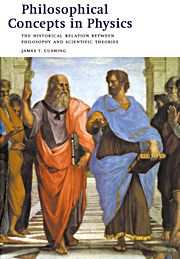 Philosophical Concepts in Physics
Philosophical Concepts in Physics Book contents
- Frontmatter
- Contents
- Preface
- Copyright acknowledgments
- PART I The scientific enterprise
- PART II Ancient and modern models of the universe
- PART III The Newtonian universe
- PART IV A perspective
- PART V Mechanical versus electrodynamical world views
- PART VI The theory of relativity
- PART VII The quantum world and the completeness of quantum mechanics
- 19 The road to quantum mechanics
- 20 Copenhagen quantum mechanics
- 21 Is quantum mechanics complete?
- PART VIII Some philosophical lessons from quantum mechanics
- PART IX A retrospective
- Notes
- General references
- Bibliography
- Author index
- Subject index
20 - Copenhagen quantum mechanics
Published online by Cambridge University Press: 05 June 2012
- Frontmatter
- Contents
- Preface
- Copyright acknowledgments
- PART I The scientific enterprise
- PART II Ancient and modern models of the universe
- PART III The Newtonian universe
- PART IV A perspective
- PART V Mechanical versus electrodynamical world views
- PART VI The theory of relativity
- PART VII The quantum world and the completeness of quantum mechanics
- 19 The road to quantum mechanics
- 20 Copenhagen quantum mechanics
- 21 Is quantum mechanics complete?
- PART VIII Some philosophical lessons from quantum mechanics
- PART IX A retrospective
- Notes
- General references
- Bibliography
- Author index
- Subject index
Summary
In a physical theory we typically describe a system in terms of its state. We specify the relevant physical quantities or variables and then use dynamical laws to find the time evolution of these variables to predict their values in the future. For example, in classical particle mechanics, the state of a system is specified by the positions and velocities (or, equivalently for us, the momenta) of all of the particles in the system (that is, r(t) and v(t) for each particle). Newton's second law, F = ma, then determines the time evolution of the variables, or of the state, of the system. For electrodynamics, the state variables are the electric and magnetic fields, E and B, and Maxwell's equations govern the time evolution of these. In classical physics (including relativity here), the state variables that are the central entities of the dynamical equations (typically the positions and momenta of the particles) are also the directly observable physical quantities. That is, the state itself is specified in terms of the observables of the theory. The essential features of the classical world view (as modified by relativity) are that the present state of a system in principle determines its future state (as in the flight of a baseball under the influence of gravity) and that the agency responsible for this event-by-event causal structure must propagate from the cause to the effect at some rate no greater than the speed of light.
- Type
- Chapter
- Information
- Philosophical Concepts in PhysicsThe Historical Relation between Philosophy and Scientific Theories, pp. 290 - 304Publisher: Cambridge University PressPrint publication year: 1998


